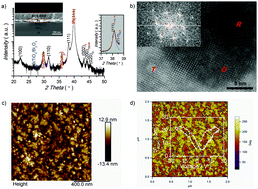Phase-transition induced giant negative electrocaloric effect in a lead-free relaxor ferroelectric thin film†
Abstract
Ferroelectric/antiferroelectric thin/thick films with large positive or negative electrocaloric (EC) effects could be very useful in designing commercial refrigeration devices. Here, a giant negative EC effect (maximum ΔT ∼ −42.5 K with ΔS ∼ −29.3 J K−1 kg−1) comparable to the best positive EC effects reported so far is demonstrated for 0.5(Ba0.8Ca0.2)TiO3–0.5Bi(Mg0.5Ti0.5)O3 (BCT–BMT) lead-free relaxor ferroelectric thin films prepared on Pt(111)/TiOx/SiO2/Si substrates using a sol–gel method. An electric-field induced structural phase transition (nanoscale tetragonal and orthorhombic to rhombohedral) along the out-of-plane [111] direction plays a very key role in developing the giant negative EC effect. This breakthrough will pave the way for practical applications of next-generation refrigeration devices with high cooling efficiency in one cycle by ingeniously utilizing and combining both the giant negative and positive EC effects. Moreover, a large energy density of 51.7 J cm−3 with a high power density of 1.15 × 1010 W kg−1 at room temperature is also achieved in the thin film, indicating that it is also an attractive multifunctional material for energy storage.



 Please wait while we load your content...
Please wait while we load your content...